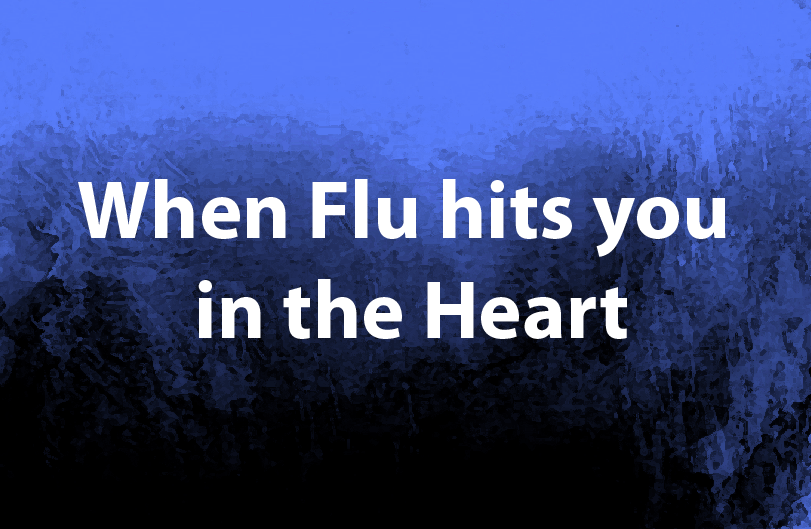Why you’re at increased risk of heart attack when you have the flu
The spike in deaths from cardiovascular disease during influenza epidemics was first recognized early in the 20th century, but the specific association of influenza with myocardial infarction was not characterized until decades later (1). A principal reason for why this association was so challenging to establish was that many people with flu symptoms don’t get tested for the virus. Nevertheless, a recent study has reported a six-times increase in the risk of myocardial infarction during the week following laboratory-confirmed infection with influenza virus compared to the year before or after the infection (2). In their recent Nature Communications article, Koupenova et al. ask why this could be.
Platelets are involved in both thrombosis and immune response
Evidence that acute bacterial and viral infections are associated with a short-term, increased risk of myocardial infarction has long been appreciated. In attempts to account for this, various mechanisms have been proposed, including that an acute inflammatory illness can cause artery-clogging plaques to become unstable and vulnerable to rupture (3), directly injure heart cells (4), or overly stress the body (5). In their study, Koupenova et al. identified platelets as the prime suspect for this increased risk of myocardial infarction. The author’s suspicion was based on platelets’ roles in mediating blood vessel blockages (thrombosis) and contributions to immune responses. Furthermore, infection with influenza and other respiratory viruses is associated with the expression of genes linked to platelet activation and risk of myocardial infarction (6). These clues allowed Koupenova et al. to focus their investigation on potential links between platelets, influenza infection, and heart attack.
Blood from flu patients contains activated platelets and aggregates of neutrophil DNA
The researchers first collected blood from 18 patients with acute influenza infection. When the platelets in the blood of these patients were examined by confocal microscopy, the authors detected activated platelets, many of which were associated with viral particles. The activated platelets found in influenza patients were also often associated with aggregates of DNA that were seemingly released by neutrophils. These DNA aggregates are reminiscent of neutrophil extracellular traps (NETs), which are networks of extracellular fibers primarily composed of DNA that bind to and often kill certain pathogens. As for all effective immune responses against pathogens, disproportionate NET formation can give rise to immunopathology. Indeed, unbalanced NET formation is associated with respiratory distress, autoimmune disease, and thrombosis.
Platelets internalize influenza
Next, the team isolated human platelets and exposed these to influenza A. In these in vitro experiments, the authors show (by transmission electron microscopy) how platelets internalize influenza in a process that is morphologically reminiscent of phagocytosis. The phagocytic activity of platelets remains controversial and, given that platelets have no nucleus in which viral replication can occur, at no point these cells were infected with the virus. The authors stress that platelets might act as the first intravascular defence mechanism: they would engulf the virus to sequester influenza from the circulation, leading to the activation of the innate immune system.
TLR7-dependent C3 release from platelets
Next, the authors investigated how platelets might contribute to the immune response to influenza infection. To do this, the team focused their attention on two key players, TLR7 (Toll Like Receptor 7, a host receptor with a major role in coordinating antiviral immune responses) and C3 (complement component 3, a protein that contributes to innate immunity). Influenza virus genomic ssRNA is known to activate TLR7 in platelets with consequent secretion of interferon, activation of the immune system, and increase of platelets’ interaction with neutrophils. Innate immunity is also triggered, with consequent activation of the complement system. Among the study participants, C3 plasma levels were increased in the influenza-infected patients relative to healthy controls. Also, in in vitro experiments, the presence of influenza virus led to an increase of C3 in platelet supernatants, but only for those platelets expressing TLR7. These findings demonstrate that the initial response against influenza is mediated by platelet-neutrophil cross-communication, which leads to C3 secretion, neutrophil-DNA release, and aggregation. This result was confirmed in in vivo murine experiments using a small-molecule inhibitor of TLR7. Based on their findings, the authors propose that platelets contribute to host immune and complement responses during influenza infection, but that this can also lead to thrombotic vascular occlusion. Might this contribute to the increased heart attack risk?
Next time you get the flu, take it easy on your heart
While the host response to intravascular pathogens is generally regulated by leukocytes, particularly neutrophils, this work suggests that platelets have an important role in the complex response of neutrophils to pathogens, particularly influenza. The increased risk of a heart attack during this period could be an unintended consequence and/or a dysregulation of this mechanism. An integrated understanding of the interplay between acute infections and the innate immunity should help in efforts to reduce the risk of myocardial infarction and other cardiovascular events following influenza infection.
References
1) Collins SD. Excess mortality from causes other than influenza and pneumonia during influenza epidemics. Public Health Rep (1896-1970) 1932;47:2159-2179
2) Kwong JC, Schwartz KL, Campitelli MA, et al. Acute myocardial infarction after laboratory-confirmed influenza infection. N Engl J Med 2018;378:345-353.
3) Libby P. Mechanisms of acute coronary syndromes and their implications for therapy. N Engl J Med 2013;368:2004-2013.
4) Brown AO, Mann B, Gao G, et al. Streptococcus pneumoniae translocates into the myocardium and forms unique microlesions that disrupt cardiac function. PLoS Pathog 2014;10(9):e1004383-e1004383.
5) Mauriello A, Sangiorgi G, Fratoni S, et al. Diffuse and active inflammation occurs in both vulnerable and stable plaques of the entire coronary tree: a histopathologic study of patients dying of acute myocardial infarction. J Am Coll Cardiol 2005;45:1585-1593.
6) Rose JJ, Voora D, Cyr DD, et al. Gene expression profiles link respiratory viral infection, platelet response to aspirin, and acute myocardial infarction. PLoS One 2015;10(7):e0132259-e0132259.




